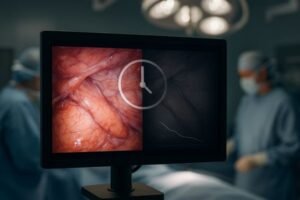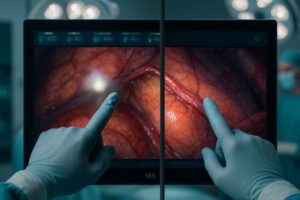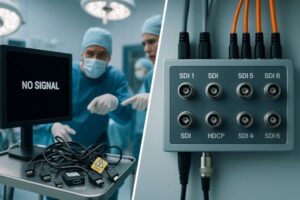In the OR, there’s no room for material failure — not even once.
Monitors face nonstop disinfection, accidental impacts, and hours of high-brightness output. Standard materials crack, overheat, or distort — often without warning. When glare hides a vessel or a screen dies mid-surgery, it’s not a glitch — it’s a threat to the patient. In surgery, reliability isn’t optional. It’s everything.
Advanced materials like aluminum alloy for enclosures, anti-reflective and shatter-proof glass, specialized internal thermal components, medical-grade plastics, and antibacterial coatings are essential. They ensure durability, clear visibility, reliable operation, resistance to harsh cleaning, and infection control in the demanding surgical environment. Our Reshin surgical monitors, such as the versatile MS270P or the high-definition MS321PB, incorporate these for optimal performance.
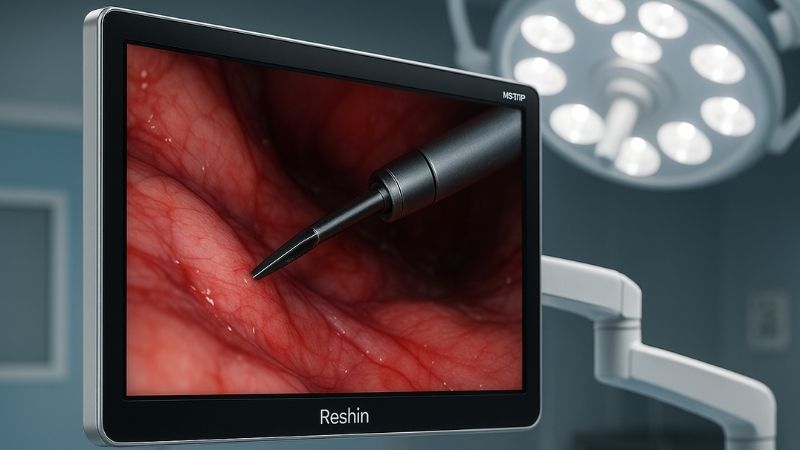
As specialists in medical monitor manufacturing, we believe that the materials chosen are not just components, but commitments to safety and precision. Let’s delve into why these specific materials are non-negotiable.
Why Is Aluminum Alloy Preferred Over Plastic for the Enclosure?
Imagine a monitor’s plastic casing cracking under the daily stress of OR adjustments or failing to dissipate heat during a long surgery. This compromises the device’s integrity and can disrupt critical procedures.
Aluminum alloy provides superior structural integrity, impact resistance, and excellent heat dissipation compared to typical plastics. This ensures the monitor, like our robust Reshin MS430PC, withstands the OR’s physical demands and maintains stable performance.
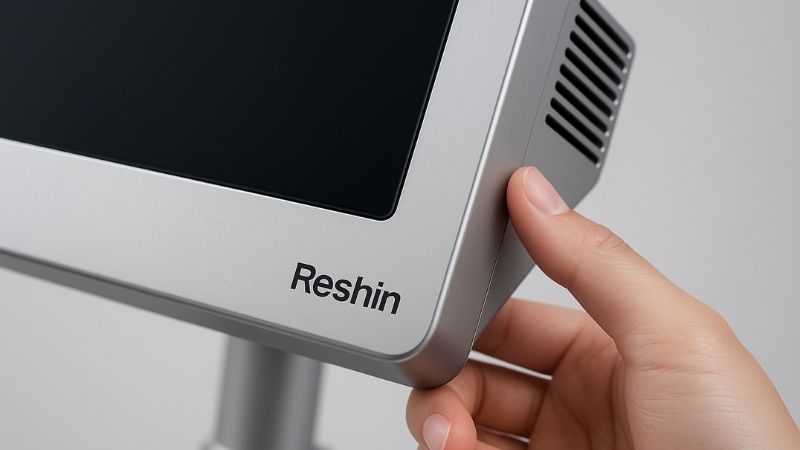
When I say, "Aluminum alloy1 isn’t chosen just because it looks professional; it’s because it performs professionally," I mean it from years of experience in surgical imaging. In the demanding environment of an operating room, equipment is constantly being moved, adjusted, and, yes, occasionally bumped. A monitor must remain solid and steady through it all. The strong yet lightweight aluminum alloy chassis used in many Reshin surgical monitors2, from the compact MS192SA to our larger displays like the MS321PC, serves as a frontline defense. This isn’t merely an aesthetic choice; it’s about ensuring long-term durability and reliability. Furthermore, surgical monitors often operate at high brightness for extended periods. Aluminum is an excellent conductor of heat, allowing the enclosure itself to act as a heat sink. This passive thermal management3 is crucial for preventing overheating, which can lead to component failure or image degradation. Unlike some plastics that can become brittle or warp over time with temperature fluctuations or repeated cleaning, aluminum maintains its structural integrity and smooth, easily cleanable surface, contributing to both longevity and hygiene. For us at Reshin, this material choice is a fundamental aspect of delivering the precision required.
Benefits of Aluminum Alloy Enclosures:
| Feature | Advantage in Surgical Settings | Reshin Example |
|---|---|---|
| Strength | High impact resistance, withstands OR rigors | MS270P |
| Lightweight | Easier to mount and maneuver | All surgical models |
| Heat Dissipation | Enhances cooling, improves component lifespan and stability | MS321PB |
| Cleanability | Smooth, non-porous surface aids effective disinfection | MS550P |
| Durability | Resists degradation from cleaning agents and physical stress | Entire surgical line |
Why Should the Display Glass Be Anti-Reflective and Shatter-Proof?
Can you imagine the frustration and potential danger if glare from bright OR lights obscured a surgeon’s view of a critical vessel? Or the catastrophic scenario of a screen shattering during a procedure?
Anti-reflective (AR) glass ensures impeccable image clarity under intense surgical lighting, minimizing glare. Shatter-proof properties are vital for safety, preventing glass fragmentation and potential contamination if the screen is accidentally damaged.
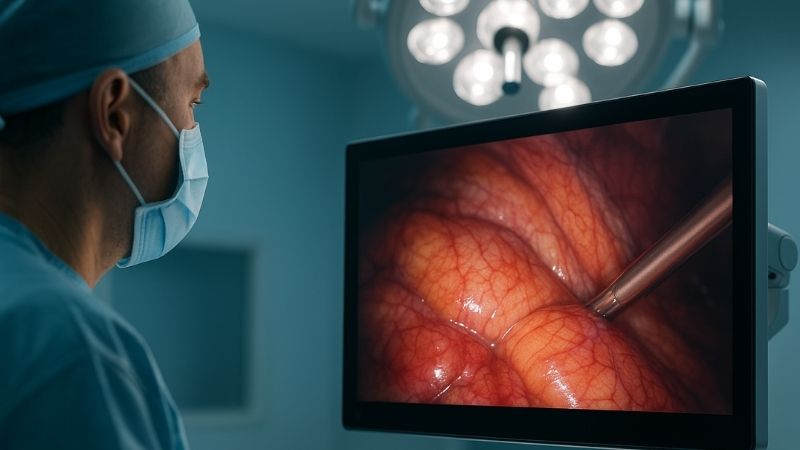
As I’ve emphasized, "Anti-reflective and shatter-resistant glass4 isn’t about marketing buzzwords. It’s about helping the surgeon clearly distinguish tissue layers under intense lighting, without glare or distraction." Operating rooms are brightly lit environments, and reflections on a standard screen can be incredibly problematic, forcing surgeons to strain their eyes or adjust their position, potentially losing focus. The AR coatings on Reshin surgical displays5, like our 4K MS275P, are meticulously engineered to minimize these reflections, ensuring a consistently clear view. "And in rare worst-case scenarios," I continue, "it’s about making sure even a broken screen won’t become a hazard." This is where shatter-proof or shatter-resistant glass6 comes in. We use toughened or laminated glass that, if broken, will not fragment into dangerous shards. This is a critical safety feature. It’s not overengineering; it’s about our fundamental commitment at Reshin: "That’s honoring every life on the table." This dedication to safety and optical performance is a hallmark across our entire surgical monitor range, ensuring that what the surgeon sees is accurate and unobstructed, allowing them to perform at their best.
Why Are Internal Thermal Materials So Crucial for Surgical Monitors?
Consider a surgical monitor, the surgeon’s window into the patient, suddenly failing due to overheating during a critical phase of an operation. This isn’t just an equipment malfunction; it’s a direct threat to patient safety.
High-performance internal thermal materials, such as copper heat pipes and high-conductivity thermal interface materials, are crucial for efficiently managing and dissipating heat generated by the display, ensuring stable, uninterrupted operation.
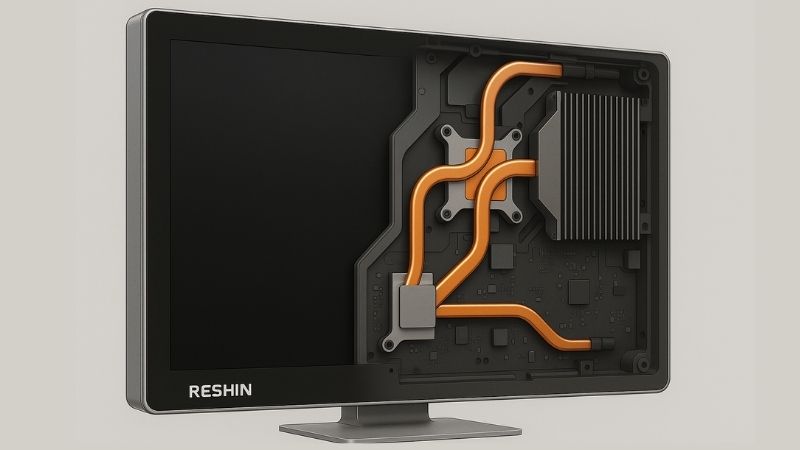
"Surgical monitors aren’t office screens," I often explain. "They operate at full brightness, for hours, without fail." This continuous, high-intensity operation, especially in 4K displays like our MS550P, generates significant heat from components like the backlight unit and internal processing boards. "Managing that heat load means using high-conductivity materials7, optimized thermal architecture, and frankly, a healthy obsession with stability." At Reshin, our R&D team, with over 200 experts averaging more than a decade of experience, focuses intensely on this. We employ advanced thermal management solutions8, which can include copper heat sinks, strategically placed heat pipes to draw heat away from critical components, and high-grade thermal interface materials to ensure efficient heat transfer. Many of our designs are fanless to prevent the circulation of airborne contaminants in the sterile OR environment, making passive heat dissipation9 even more critical. "Because when the screen fails," I always stress, "so does the surgeon’s window into the body." This commitment to thermal stability is one reason why global brands like Philips and Siemens trust Reshin for their display needs; they know our monitors are built for sustained, reliable performance
What’s the Difference Between Medical-Grade and Regular Plastics?
Using standard plastics in an OR setting that degrade from disinfectants or potentially leach harmful chemicals? This is an unacceptable risk, compromising sterility and patient well-being.
Medical-grade plastics are specifically engineered and rigorously tested for biocompatibility (e.g., ISO 10993) and superior resistance to harsh chemical disinfectants commonly used in operating rooms, ensuring safety and durability.
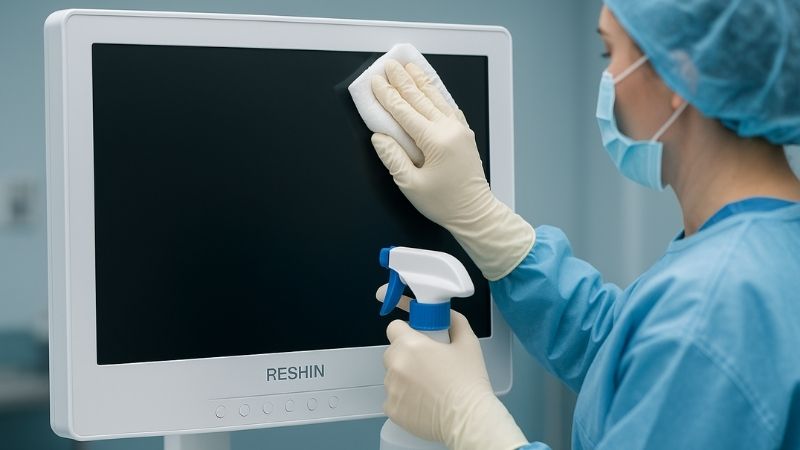
When discussing materials for any part of a surgical monitor that might be exposed, I always emphasize: "They have to be [medical-grade10]." This isn’t optional. Operating rooms are subjected to stringent cleaning protocols involving potent disinfectants like alcohol-based solutions, hydrogen peroxide, and quaternary ammonium compounds. Regular plastics can quickly degrade—crack, yellow, become brittle—under such chemical onslaught. Medical-grade plastics, however, are formulated to withstand these chemicals repeatedly without losing their integrity or appearance. "Resistant to alcohol, hydrogen peroxide, and harsh disinfectants11, and tested for biocompatibility under ISO 10993, these plastics are built to survive the daily rigors of the OR," I explain. This biocompatibility12 testing is crucial to ensure that the materials do not cause any adverse biological reactions. "They don’t leach, don’t yellow, and don’t compromise." For Reshin, even for components on more compact models like the MS220S or MS247SA, if they form part of the external, cleanable surface, they must meet these stringent criteria. As I tell our OEM partners, like Alex Müller at Mediview Technologies who relies on fully compliant components, “‘Almost safe’ isn’t safe enough when it comes to infection control.”
Why Must High-End Surgical Displays Have Antibacterial Properties?
The thought of a monitor surface, frequently touched in the OR, becoming a potential reservoir for bacteria? This invisible threat directly undermines infection control and endangers patients.
High-end surgical displays must incorporate antibacterial properties, often through silver ion technology or antimicrobial polymers embedded in materials, to actively inhibit microbial growth on their surfaces, bolstering OR sterility.

"Antibacterial coatings aren’t just a nice-to-have; they’re a response to real infection risks," is a point I consistently make. Hospital-Acquired Infections (HAIs)13 are a significant concern, and any surface in the operating room, especially high-touch equipment like monitors, can potentially contribute to cross-contamination if not managed properly. "Silver ion treatments, antimicrobial polymers14 — these aren’t buzzwords, they’re weapons." These technologies work by releasing ions or having inherent properties that disrupt bacterial cell functions, inhibiting their growth and proliferation on the monitor’s housing or even the screen itself. While regular and thorough disinfection is paramount and irreplaceable, these antibacterial properties provide an additional, continuous layer of protection. Dr. Emily Chen, in her role procuring equipment for Hong Kong United Hospital, always prioritizes features that enhance patient safety, and antibacterial surfaces contribute to this. "Every surface we engineer is part of a larger mission: to make sure our monitors help preserve the sterile field, not threaten it." At Reshin, where our products are used in over 100,000 hospitals worldwide, this commitment to safety is integral to our design philosophy for all our displays, including specialized surgical monitors like the MS430PC.
Conclusion
The deliberate selection of advanced materials like aluminum alloy, specialized glass, robust thermal components, medical-grade plastics, and antibacterial surfaces is fundamental to Reshin surgical monitors, ensuring unparalleled safety, reliability, and optical performance.
- Explore how aluminum alloy enhances durability and performance in surgical monitors, ensuring reliability in critical environments. ↩
- Learn about essential features of surgical monitors to ensure optimal performance and reliability in operating rooms. ↩
- Discover the importance of passive thermal management in preventing overheating and ensuring device longevity. ↩
- Explore how anti-reflective and shatter-resistant glass enhances surgical precision and safety, crucial for successful operations. ↩
- Discover the technology behind AR coatings and their role in providing clear, glare-free visuals for surgeons, enhancing their focus and performance. ↩
- Learn about the importance of shatter-resistant glass in preventing hazards during surgeries, ensuring safety for both patients and surgeons. ↩
- Learn about high-conductivity materials and their role in improving heat dissipation in electronic devices, crucial for surgical monitors. ↩
- Explore this link to understand how advanced thermal management solutions enhance the reliability and performance of surgical monitors. ↩
- Discover the principles of passive heat dissipation and its importance in maintaining the performance of surgical monitors in sterile environments. ↩
- Explore the importance of medical-grade materials in surgical monitors to ensure safety and compliance in operating rooms. ↩
- Learn about the disinfectants that can be safely used on medical equipment to maintain hygiene without damaging materials. ↩
- Understanding biocompatibility testing can help ensure that medical devices do not cause adverse reactions, crucial for patient safety. ↩
- Understanding HAIs is crucial for improving patient safety and implementing effective infection control measures. ↩
- Learn about the innovative use of antimicrobial polymers in medical devices to combat infections and improve patient outcomes. ↩

